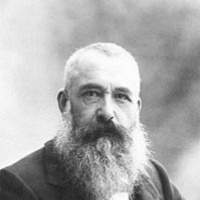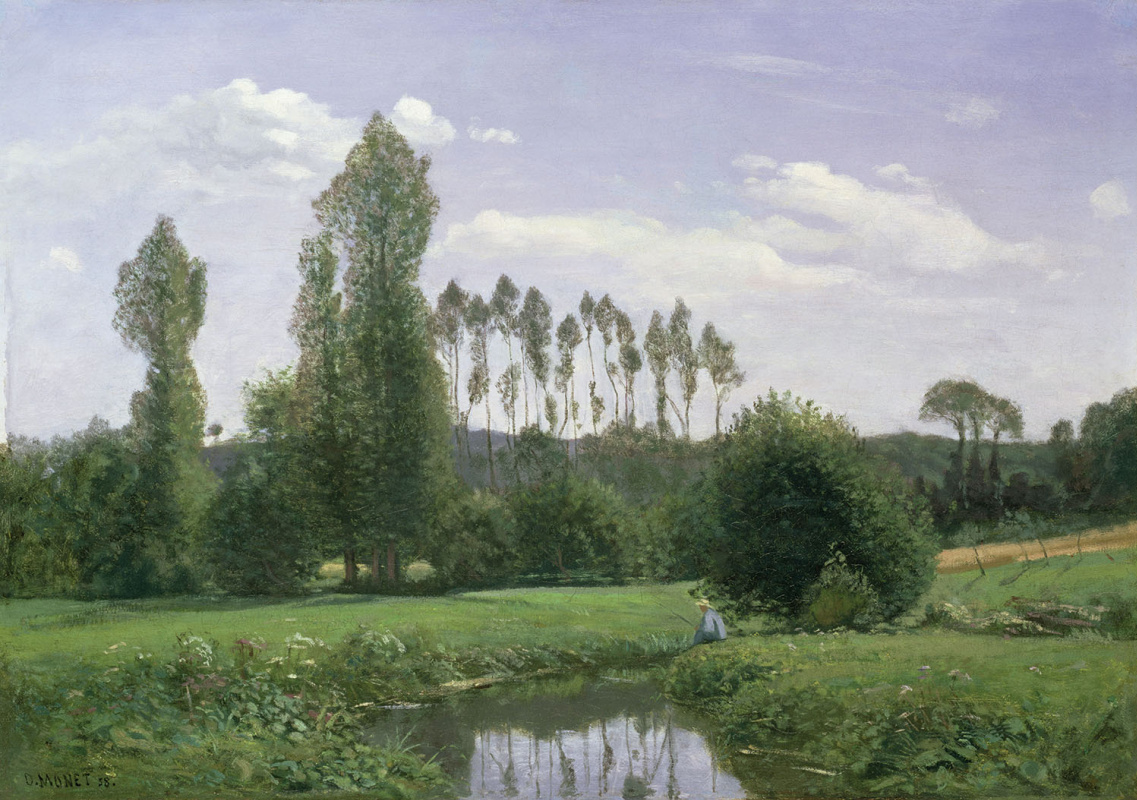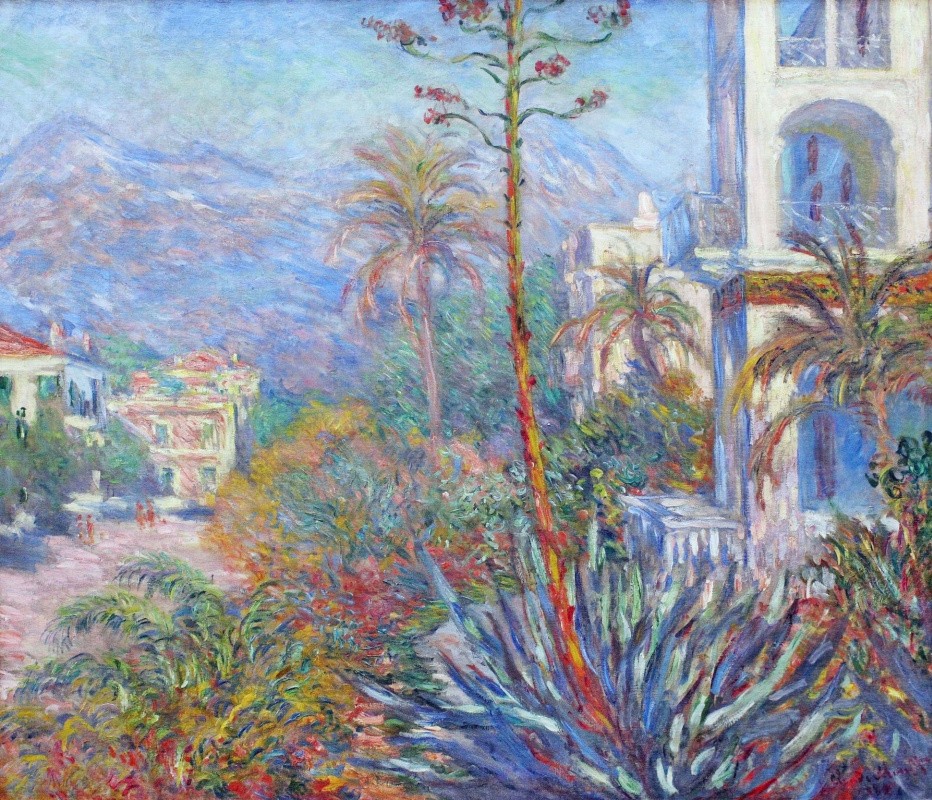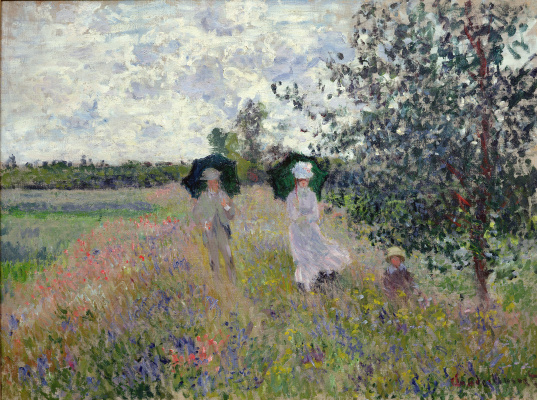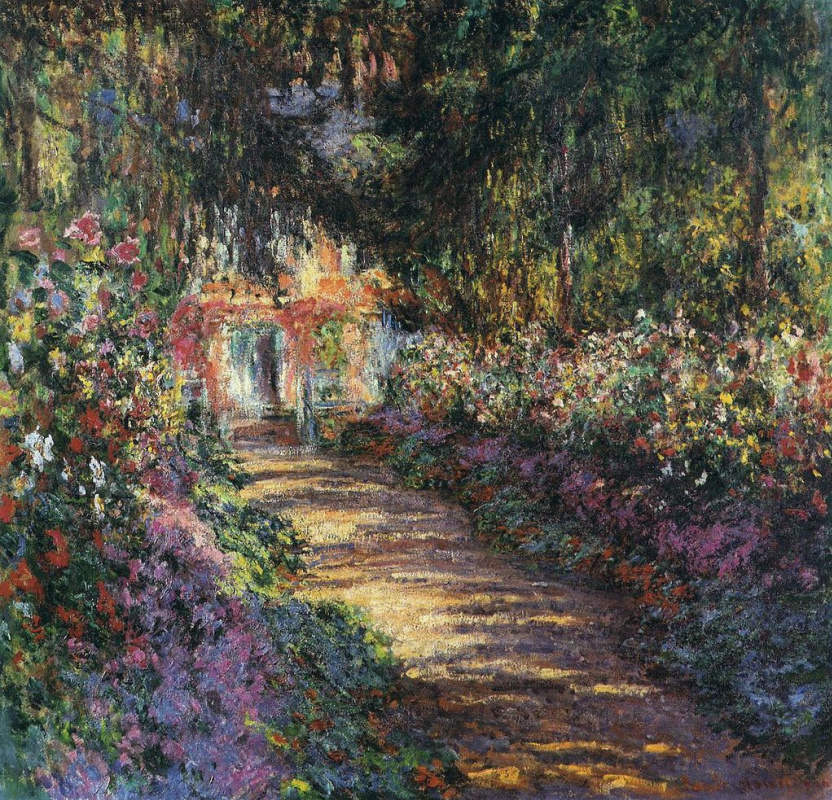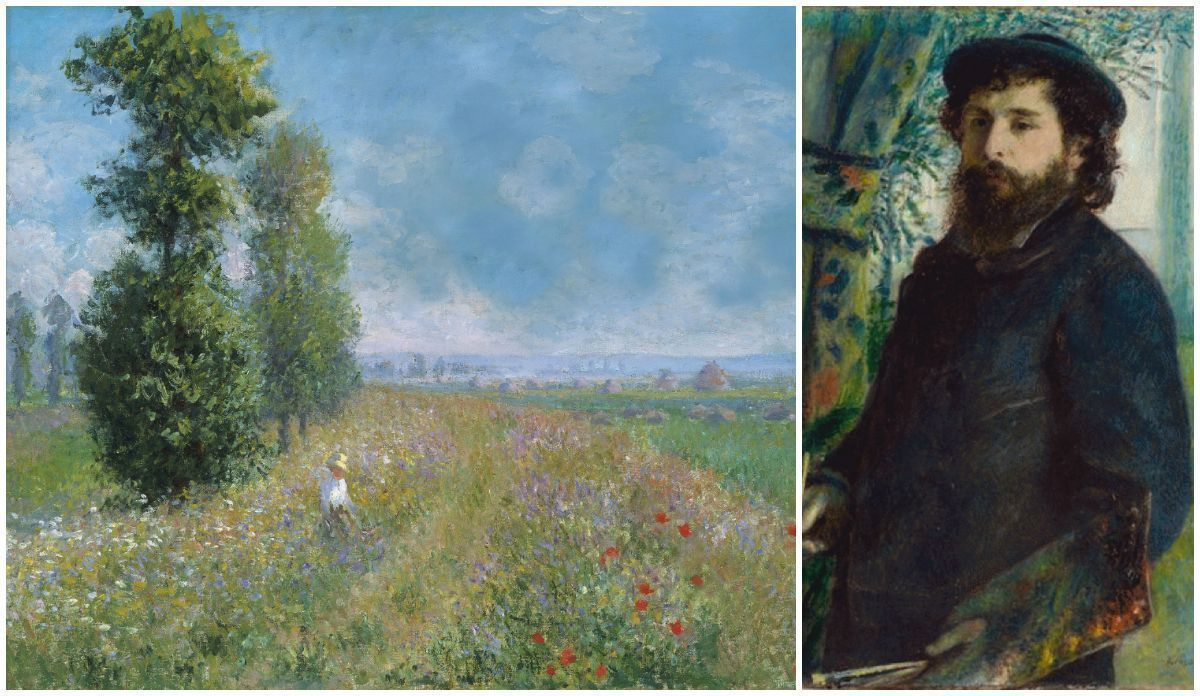
The life story of Claude Monet, whatever the biographer she undertook, rarely complete without ophthalmic medical revelations and mysteries. Some seriously argued that Monet's eyes have a special structure and the retina it is arranged quite differently than other people. Other – deliberately or accidentally uses vivid metaphors about the scorched eyes and sleeping blanket. Still others are trying to find out what scientific works are about the color spectrum, influenced the works of Monet and laid the Foundation of his view of the world. Paul Cezanne once said about Monet is wonderful and, most likely, a joke: "Monet is just an eye. But, my God, what eyes!"

Claude Monet at Giverny, 1915
To learn to see
Claude Monet once shared his dream with the American artist impressionistka Lila Cabot Perry: "I wish I'd been born blind and then suddenly to see the light - so to begin writing, not knowing what are the items that I see". Monet was not lucky, he was born sighted, but all his life tried to write as if he sees the world for the first time, examining with delight the details and not trying to analyze and find meanings.
Claude was an innate intolerance of any coherent method of teaching, he wanted to spit on the lessons of academic drawing and classical composition, he yawned or was angry when he expounded a "system of knowledge". And every time I ran. Talking about their first true teachers, The Eugène Budenaand Jan Jongkind, Monet so directly and said they have developed my vision, learn to see. No schools, no teachers, no theories, he'd never need. One only vision.
Вид близ Рюэль-ле-Гавр
1858, 46×55 см
"The view is not Ruel-Le-Havre" the first paintings 18-year-old Monet, written in the open air in the company of a stooped skinny sailor eugène Boudin, who Camille Corot called the "king of heaven". Monet claimed to have experienced at the present day insight, changed his life.

Claude Monet of his pond with water lilies, 1905.
To feel
Many zeros in the auction prices for works of art is for the most part business is good marketing, but not in the case of Claude Monet. His paintings are absolutely unscientific, and always unexpectedly produce a hypnotic, tickled sweet, treacherously relaxing experience.
Виллы Бордигеры
1884, 115×130 см
Quest of the Impressionists has always revolved around this very idea: to cleanse the world picture of the meanings and stories – and fill it with emotions. Modern psychologists, revealing to his professional bell the secrets of impressionist painting, argue that these artists were able technically to portray the world the way it sees the newborn child is ambiguous and unclear. And we are looking for "Haystack"or "Pond with water lilies" involuntarily include psychophysiological memory of that time perceived and evaluated what is happening around is very simple: pleasant-unpleasant, safe-dangerous, tasty-tasteless. Not really knowing what it all means.
"Try to forget that you see before you - a tree, house, field, whatever. Just think that this place is a small blue square, there is an oblong pink shape, and continue until, until you appear naive impressions of the painting, which is in front of your eyes" - this recommendation is already the genius of Monet's young artists is much more than a painting class. It's a lesson a child's worldview, the only conditions for the creation of the emotional picture. Critics add that in the instructions – and even clearly formulated the principle of the art of the future, abstract.
"Try to forget that you see before you - a tree, house, field, whatever. Just think that this place is a small blue square, there is an oblong pink shape, and continue until, until you appear naive impressions of the painting, which is in front of your eyes" - this recommendation is already the genius of Monet's young artists is much more than a painting class. It's a lesson a child's worldview, the only conditions for the creation of the emotional picture. Critics add that in the instructions – and even clearly formulated the principle of the art of the future, abstract.

Claude Monet and Georges Clemenceau on the Japanese bridge at Giverny, 1921
To live eyes
Famous, eloquent, and beloved by the French politician, "father of victory", Georges Clemenceau was the close friend of Monet in the last few decades of his life, a close neighbor and the inspiration behind the famous murals of water lilies, which are now in the oval hall of the Musee d'orsay. And how happy a rare combination, a great connoisseur of art. But before all these glorified its fields of operation, Clemenceau was a doctor. But because of the insistent talk about "the unique retina" Monet in his mouth should be taken rather as a scientific term and attempt to study, not as a figurative expression. For example here: "Claude Monet's garden can be considered one of his works, the artist miraculously realized the idea of transformation of nature according to the laws of light painting. His workshop was not restricted to the walls, she stepped into the open air, where everywhere was scattered color palette to train your eye and satisfy the insatiable appetite of the retina, ready to take the slightest flutter of life".
"If you closely look into the cathedrals of Monet, the feeling that they are written by some iridescent mortar, thrown on the canvas in a fit of rage. But in her wild flash as much passion, how much verified knowledge. How did the artist separated from his canvases only a few inches, to capture the subtle yet precise effect that can be detected only at a distance? Obviously, due to the mysterious characteristics of the retina. But for me the most important thing is that I see the whole community as a whole, in its sovereign Majesty and power", wrote to Clemenceau on the famous series depicting the Rouen Cathedral.
There is a great temptation to attribute the genius of Monet at the expense of physiological talent, but the most interesting begins further. His last masterpieces, the artist will create already practically blind when retin-a stopped working.
There is a great temptation to attribute the genius of Monet at the expense of physiological talent, but the most interesting begins further. His last masterpieces, the artist will create already practically blind when retin-a stopped working.

Claude Monet on the path of his garden in Giverny.
Learn not to see
Sunshine, hot summer and icy winter, every day they burned the eyes of Claude Monet, inevitable. He was healthy and strong, hardy and vigorous in his 60-plus. But every year has seen worse. Lens dimmed and grew turbid, with his fantastically tuned nature of the retina receive less light, colors seen dull, and dull, on the whole world as if threw a yellowish filter.

On the sites of modern ophthalmic clinics you can find pictures, simulating the view of the world with cataract (top photo).
Archiv processed photos from Monet's garden at Giverny so that you can imagine to see your flower beds suffering from cataracts, Claude Monet. And compared them with the later works of the artist. (Originals of images of the garden in Giverny: dturista.com).
Archiv processed photos from Monet's garden at Giverny so that you can imagine to see your flower beds suffering from cataracts, Claude Monet. And compared them with the later works of the artist. (Originals of images of the garden in Giverny: dturista.com).


1. Photo of garden in Giverny.
2. Reconstruction: how does this flowerbed people with cataracts.
2. Reconstruction: how does this flowerbed people with cataracts.
Дорожка через сад в Живерни
1902, 89×92 см


1. Photo of the famous bridge by Claude Monet.
2. Reconstruction: as can see, this bridge is experiencing vision problems Claude Monet.
2. Reconstruction: as can see, this bridge is experiencing vision problems Claude Monet.
Пруд с водяными лилиями (Японский мостик)
1900, 90.2×92.7 см
My most favorite paintings Monet did not sign, so as not to be tempted to sell them. And only the closest friends and only in the most successful days might try to get something from this collection. Actor and Director, Sasha Guitry took several months to persuade Claude to sell him one of them, the work of the old stock. Monet sighed, put his signature on the canvas, and whispered: "Look, Sasha. I signed her 81st year, although in reality it is the work of 82-year. I do not want you to cheat. Just the fact that unit I to write easier than a deuce..."
He was 72 when doctors made a conclusion: cataract in both eyes, visual acuity of the left eye is one – tenth the norm, the right eye can distinguish only light.
The doctors explain what is happening with cataract, the processes of color vision: the lens performs an important protective function - absorbs light waves before they reach the retina. Over time, the lens becomes cloudy and turns yellow and begins to absorb more shortwave, distorting this way the color flows that fall on the retina. So, the retina of the eye of the artist has not received reliable information about the world due to lens opacity.
He was 72 when doctors made a conclusion: cataract in both eyes, visual acuity of the left eye is one – tenth the norm, the right eye can distinguish only light.
The doctors explain what is happening with cataract, the processes of color vision: the lens performs an important protective function - absorbs light waves before they reach the retina. Over time, the lens becomes cloudy and turns yellow and begins to absorb more shortwave, distorting this way the color flows that fall on the retina. So, the retina of the eye of the artist has not received reliable information about the world due to lens opacity.

Claude Monet, August 27, 1905.
Dr. Kotla certainly aware of what he does, and so he was desperate brave with the transcendent self: he offered to do the surgery on the eyes. Eye surgery, Monet! Claude then angry, then screaming, then silent all day, then complains to his friend Georges Clemenceau, to shiver in fear a single mention of the clinic and the doctor: "How do I know, maybe they'll give me the other eye? And I need the eyes of Monet! Otherwise I will continue to work?"
Dr. Kotla certainly aware of what he does, and so he was desperate brave with the transcendent self: he offered to do the surgery on the eyes. Eye surgery, Monet! Claude then angry, then screaming, then silent all day, then complains to his friend Georges Clemenceau, to shiver in fear a single mention of the clinic and the doctor: "How do I know, maybe they'll give me the other eye? And I need the eyes of Monet! Otherwise I will continue to work?"
Features of color vision person cataract, doctors are already in the Venetian cycle of Claude Monet. But the closer to 1923, when the artist decided on surgery, the more clear and present look of these changes.
To the lungs, grateful patients Claude Monet is not exactly treated. In the Paris clinic of Dr. Kotla he arrived exhausted and desperate, seeing the approaching eyes with a scalpel, panicked, the attack began with nausea and vomiting. After the patient was strictly prescribed postoperative three days of immobility. The first night, Monet tried to rip off the bandage and in a fit of rage screaming that it better blind than three days, laying motionless.
All of these operations on the right eye of Claude Monet doctor Kotla spent three. But the expected result they never brought the world once again swam before his eyes. Only now the operated eye, which was removed the lens was susceptible to short waves and saw everything in a rich blue-purple color. While the left eye continued to see everything in yellow. The brain can't combine the two images showed a bifurcated picture. "Better to be blind than to see nature as I see it I"- in desperation, says Monet. And returned to work on his latest masterpiece.
To the lungs, grateful patients Claude Monet is not exactly treated. In the Paris clinic of Dr. Kotla he arrived exhausted and desperate, seeing the approaching eyes with a scalpel, panicked, the attack began with nausea and vomiting. After the patient was strictly prescribed postoperative three days of immobility. The first night, Monet tried to rip off the bandage and in a fit of rage screaming that it better blind than three days, laying motionless.
All of these operations on the right eye of Claude Monet doctor Kotla spent three. But the expected result they never brought the world once again swam before his eyes. Only now the operated eye, which was removed the lens was susceptible to short waves and saw everything in a rich blue-purple color. While the left eye continued to see everything in yellow. The brain can't combine the two images showed a bifurcated picture. "Better to be blind than to see nature as I see it I"- in desperation, says Monet. And returned to work on his latest masterpiece.

The smoke break. Claude Monet writes a panel with water lilies to Rodin Museum, 1926.
Instead of view
"A cataract forced him to not believe the vision and imagination"- says British art critic Waldemar Januszczak. 8 huge murals that in the oval rooms of the Museum courtyard create a feeling permeating nursing, resonant, enveloping water of infinity, was written by 86-year-old artist without the lens in the right eye and cataract on the left.
Водяные лилии
1926
Ненюфары
1926, 602×219 см
Surrealist painter Andre Masson called installation in Paris, the Sistine chapel of impressionism.
Title illustration: Claude Monet, "Poplar alongside Argentea", 1875, Auguste Reoir, "Portrait Of Claude Monet", 1875
Author: Anna SidelnikaVA
Reconstruction photo: Tatyana Somova
Title illustration: Claude Monet, "Poplar alongside Argentea", 1875, Auguste Reoir, "Portrait Of Claude Monet", 1875
Author: Anna SidelnikaVA
Reconstruction photo: Tatyana Somova
